Global Cloud Kitchen Market By Offering, By Type, By End User, By Region & Segmental Insights Trends and Forecast, 2024 – 2034
- Industry: Technology
- Report ID: TNR-110-1248
- Number of Pages: 420
- Table/Charts : Yes
- August, 2024
- Base Year : 2024
- No. of Companies : 10+
- No. of Countries : 29
- Views : 10106
- Covid Impact Covered: Yes
- War Impact Covered: Yes
- Formats : PDF, Excel, PPT
The global cloud kitchen market is experiencing robust growth, driven by the surge in online food delivery services and changing consumer preferences toward convenience and variety. Key growth drivers include the expansion of delivery platforms, the rise in demand for quick-service restaurants, and advancements in kitchen technology that enhance operational efficiency.
Notable trends include the adoption of hybrid kitchen models, the integration of AI for streamlined operations, and the increasing collaboration between cloud kitchens and food delivery platforms. Opportunities abound in emerging markets, where urbanization and the rise of digital connectivity are fostering demand for cloud kitchen services. As the market evolves, players are focusing on scalability, innovative menu offerings, and strategic partnerships to capitalize on growth prospects. In terms of revenue, the global cloud kitchen market was worth US$ 5.5 Bn in 2023, anticipated to witness a CAGR of 16.5% during 2024 – 2034.
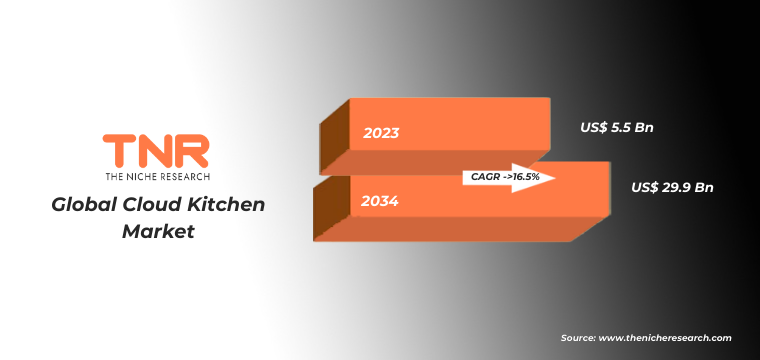
Global Cloud Kitchen Market Dynamics
Global Cloud Kitchen Market Growth Driver:
The global cloud kitchen market is propelled by the exponential growth in online food delivery services, driven by changing consumer preferences for convenience and variety. The proliferation of smartphone usage and increasing internet penetration are facilitating easier access to food delivery apps, further fueling demand. Additionally, the lower operational costs associated with cloud kitchens compared to traditional restaurants make this model attractive for both new entrants and established players. The scalability and flexibility of cloud kitchens, along with the ability to experiment with diverse cuisines and menu offerings without the constraints of physical dining space, are significant drivers boosting market expansion.
Global Cloud Kitchen Market Restraint:
Despite its rapid growth, the global cloud kitchen market faces several challenges. High reliance on third-party delivery platforms can erode profit margins due to commission fees. Intense competition within the market, including from traditional restaurants entering the cloud kitchen space, can make it difficult for new entrants to gain a foothold. Additionally, maintaining consistent food quality across different locations and ensuring timely delivery can be operationally challenging. Market fragmentation, with varying consumer preferences across regions, adds complexity to scaling operations. Moreover, regulatory hurdles, such as food safety standards and local zoning laws, can pose barriers to expansion.
Global Cloud Kitchen Market Opportunity:
The global cloud kitchen market presents significant opportunities, particularly in emerging economies where urbanization and digital connectivity are on the rise. Expanding into untapped regions with growing demand for online food delivery offers potential for market growth. The adoption of advanced technologies, such as AI-driven kitchen management systems and data analytics for personalized customer experiences, can further enhance operational efficiency and customer satisfaction. Strategic partnerships with food delivery platforms and leveraging social media for targeted marketing can help cloud kitchen operators expand their customer base. Additionally, the growing trend of health-conscious eating opens avenues for niche cloud kitchens specializing in healthy, organic, or diet-specific cuisines.
Global Cloud Kitchen Market Threat:
The global cloud kitchen market is not without its threats. Economic downturns and fluctuating consumer spending can impact demand for food delivery services. The market’s heavy dependence on third-party delivery platforms also exposes cloud kitchens to risks related to service disruptions, changes in commission structures, and potential loss of control over customer interactions. Cybersecurity threats pose a significant risk as cloud kitchens increasingly rely on digital platforms for operations. Furthermore, the potential saturation of key markets and increasing regulatory scrutiny, particularly around food safety and labor practices, could stifle growth. Lastly, evolving consumer preferences may shift away from delivery, favoring dine-in experiences post-pandemic.
Global Cloud Kitchen Market Segmental Analysis:
Cloud Kitchen Market By Offering
- Solution
- Services
Services segment has rapidly emerged as the fastest-growing segment in the global cloud kitchen market, driven by increasing demand for efficient and scalable solutions that support kitchen operations. This includes services like kitchen management software, inventory tracking, and data analytics, which enable cloud kitchens to streamline their processes and improve operational efficiency. Additionally, partnerships with third-party delivery platforms and technology providers have further propelled growth by offering integrated services that enhance customer experience and optimize delivery logistics. The rise of outsourced services, such as customer support, marketing, and IT management, has also contributed to this segment’s rapid expansion, as cloud kitchens seek to focus on core food production activities.
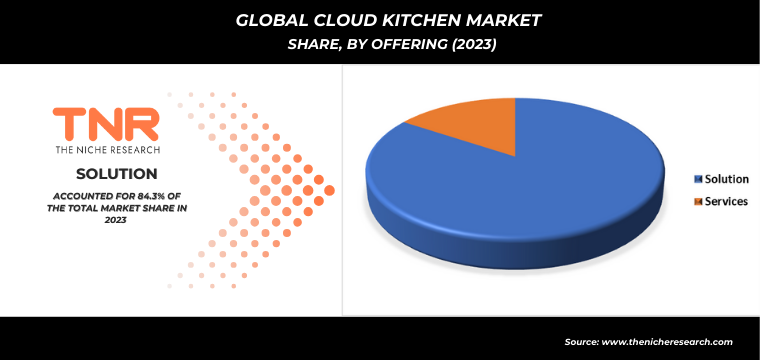
Cloud Kitchen Market By Type
- Independent Cloud Kitchen
- Shared Cloud Kitchen
- Others
In 2023, the shared cloud kitchen segment dominated the global cloud kitchen market, capturing a substantial revenue share of 48.5%. This dominance is attributed to the segment’s ability to offer cost-effective solutions by allowing multiple brands to operate from a single location, thereby reducing overhead costs and maximizing space utilization. Shared cloud kitchens also benefit from economies of scale, making them attractive to both established food brands and startups looking to enter the market with lower capital investment. Additionally, the flexibility to test new concepts and rapidly scale successful brands within these shared spaces has further fueled their popularity and market share.
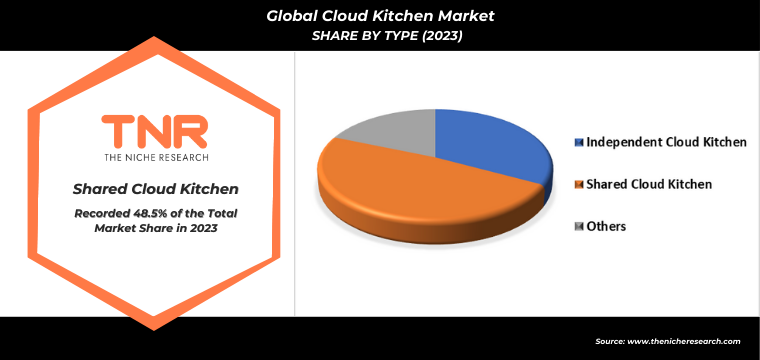
Cloud Kitchen Market By End User
- Individuals
- Corporates
Corporates by end user category dominated the global cloud kitchen market in 2023 with a revenue share of 54.8% owing to growing demand for corporate catering and meal solutions tailored to businesses, particularly in urban areas where office employees seek convenient, high-quality meal options. Corporates are increasingly partnering with cloud kitchens to provide diverse, customized food offerings for meetings, events, and daily meals, capitalizing on the efficiency and flexibility cloud kitchens offer. Additionally, the trend of companies outsourcing their food services to cloud kitchens, combined with the rise of hybrid work models, has significantly boosted the demand in this segment, solidifying its market dominance.
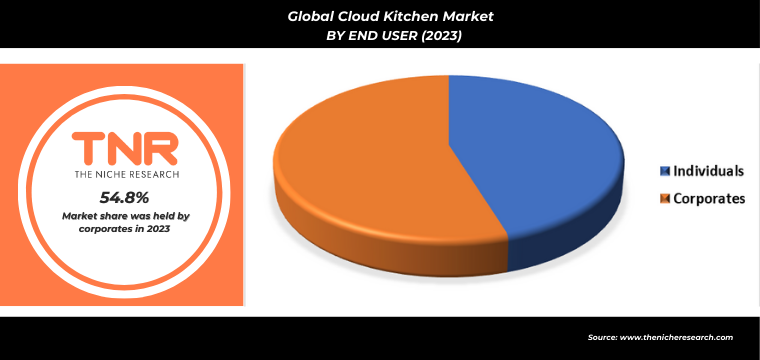
Cloud Kitchen Market By Region
- North America (U.S., Canada, Mexico, Rest of North America)
- Europe (France, The UK, Spain, Germany, Italy, Nordic Countries (Denmark, Finland, Iceland, Sweden, Norway), Benelux Union (Belgium, The Netherlands, Luxembourg), Rest of Europe)
- Asia Pacific (China, Japan, India, New Zealand, Australia, South Korea, Southeast Asia (Indonesia, Thailand, Malaysia, Singapore, Rest of Southeast Asia), Rest of Asia Pacific)
- Middle East & Africa (Saudi Arabia, UAE, Egypt, Kuwait, South Africa, Rest of Middle East & Africa)
- Latin America (Brazil, Argentina, Rest of Latin America)
Latin America is projected to be the fastest-growing region in the cloud kitchen market during the forecast period, driven by rapid urbanization and increasing adoption of online food delivery services across major cities. The region’s young, tech-savvy population is fueling demand for convenient, on-demand dining options, while the growth of digital payment infrastructure supports the expansion of online food ordering. Additionally, the relatively low penetration of traditional restaurant chains in some areas creates a favorable environment for cloud kitchens to thrive. The entry of global food delivery platforms and investments in local cloud kitchen startups are further accelerating market growth, making Latin America a key area of focus for industry players.

Competitive Landscape
The global cloud kitchen market is highly competitive, with key players like Rebel Foods, Kitchen United, and DoorDash leading the charge. Competition intensifies as traditional restaurants adopt cloud kitchen models, while startups and established brands vie for market share through innovative business models and technological advancements.
Some of the players operating in the cloud kitchen market are
- Cloud Kitchen
- Dahmakan
- Deliverect
- DoorDash Kitchen
- Ghost Kitchen Orlando
- Keatz
- Kitchen United
- Kitopi
- Rebel Foods
- Starbucks (Star Kitchen)
- Zuul Kitchen
- Other Industry Participants
Global Cloud Kitchen Market Scope
| Report Specifications | Details |
| Market Revenue in 2023 | US$ 5.5 Bn |
| Market Size Forecast by 2034 | US$ 29.9 Bn |
| Growth Rate (CAGR) | 16.5% |
| Historic Data | 2016 – 2022 |
| Base Year for Estimation | 2023 |
| Forecast Period | 2024 – 2034 |
| Report Inclusions | Market Size & Estimates, Market Dynamics, Competitive Scenario, Trends, Growth Factors, Market Determinants, Key Investment Segmentation, Product/Service/Solutions Benchmarking |
| Segments Covered | By Offering, By Type, By End User, By Region |
| Regions Covered | North America, Europe, Asia Pacific, Middle East & Africa, Latin America |
| Countries Covered | U.S., Canada, Mexico, Rest of North America, France, The UK, Spain, Germany, Italy, Nordic Countries (Denmark, Finland, Iceland, Sweden, Norway), Benelux Union (Belgium, The Netherlands, Luxembourg), Rest of Europe, China, Japan, India, New Zealand, Australia, South Korea, Southeast Asia (Indonesia, Thailand, Malaysia, Singapore, Rest of Southeast Asia), Rest of Asia Pacific, Saudi Arabia, UAE, Egypt, Kuwait, South Africa, Rest of Middle East & Africa, Brazil, Argentina, Rest of Latin America |
| Key Players | Cloud Kitchen, Dahmakan, Deliverect, DoorDash Kitchen, Ghost Kitchen Orlando, Keatz, Kitchen United, Kitopi, Rebel Foods, Starbucks (Star Kitchen), Zuul Kitchen |
| Customization Scope | Customization allows for the inclusion/modification of content pertaining to geographical regions, countries, and specific market segments. |
| Pricing & Procurement Options | Explore purchase options tailored to your specific research requirements |
| Contact Details | Consult With Our Expert
Japan (Toll-Free): +81 663-386-8111 South Korea (Toll-Free): +82-808- 703-126 Saudi Arabia (Toll-Free): +966 800-850-1643 United Kingdom: +44 753-710-5080 United States: +1 302-232-5106 E-mail: askanexpert@thenicheresearch.com
|
Key Developments:
- In January 2024, ITC is set to broaden its cloud kitchen operations, with plans to enter key markets in Mumbai, Delhi, and Kolkata. The business strategy involves a central kitchen supported by several satellite kitchens, catering to the needs of delivery platforms like Swiggy and Zomato, which favor kitchens located every 2.5 to 3 kilometers.
- In July 2023, Rebel Foods expanded into the Saudi Arabian market by launching two cloud kitchens in Riyadh. The company also has plans to open 60 internet restaurants across the city within the following year.
Report Layout:
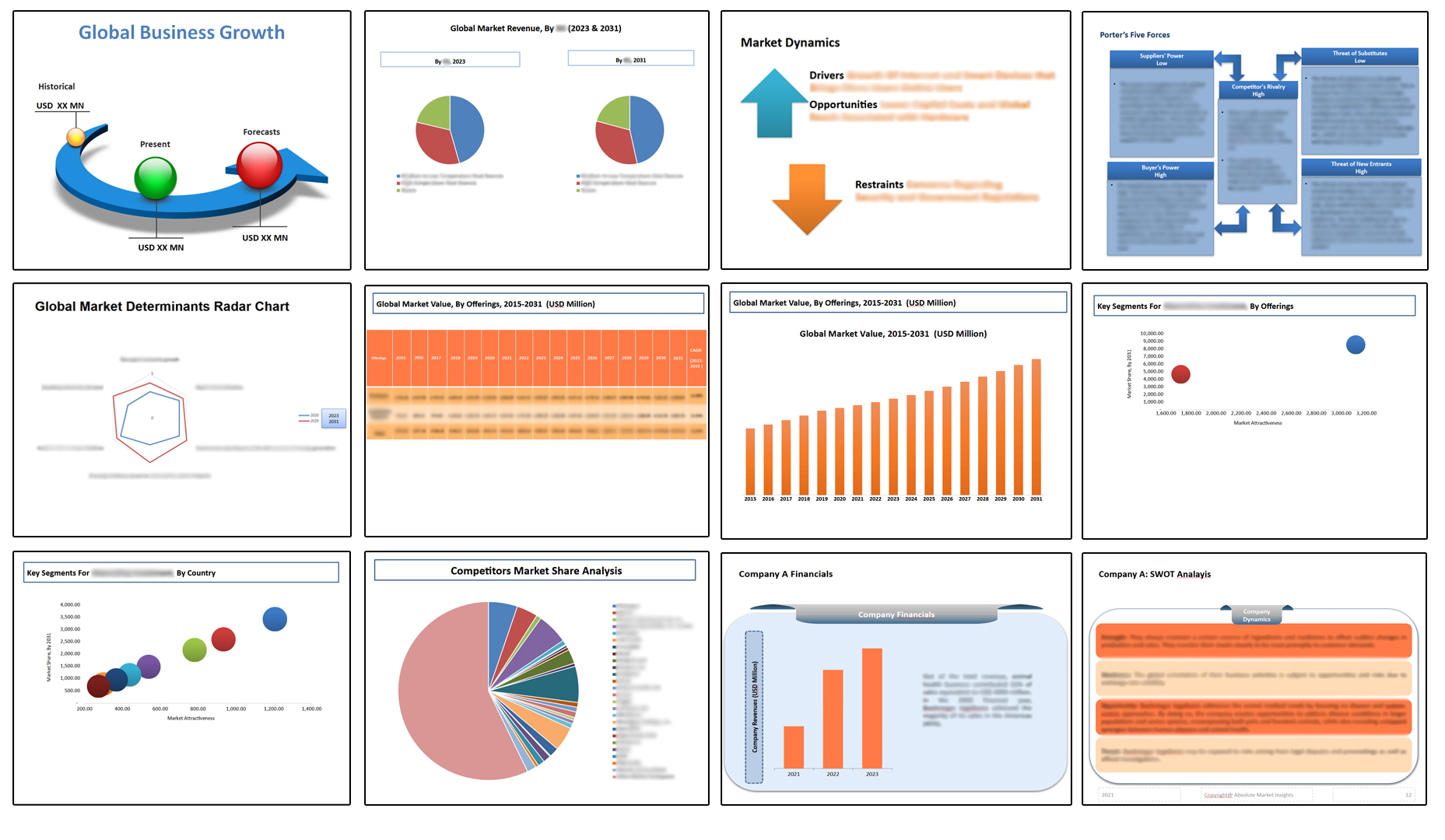
Table of Contents
Note: This ToC is tentative and can be changed according to the research study conducted during the course of report completion.
**Exclusive for Multi-User and Enterprise User.
Global Cloud Kitchen Market
By Offering
- Solution
- Services
By Type
- Independent Cloud Kitchen
- Shared Cloud Kitchen
- Others
By End User
- Individuals
- Corporates
By Region
- North America (U.S., Canada, Mexico, Rest of North America)
- Europe (France, The UK, Spain, Germany, Italy, Nordic Countries (Denmark, Finland, Iceland, Sweden, Norway), Benelux Union (Belgium, The Netherlands, Luxembourg), Rest of Europe)
- Asia Pacific (China, Japan, India, New Zealand, Australia, South Korea, Southeast Asia (Indonesia, Thailand, Malaysia, Singapore, Rest of Southeast Asia), Rest of Asia Pacific)
- Middle East & Africa (Saudi Arabia, UAE, Egypt, Kuwait, South Africa, Rest of Middle East & Africa)
- Latin America (Brazil, Argentina, Rest of Latin America)
The Niche Research approach encompasses both primary and secondary research methods to provide comprehensive insights. While primary research is the cornerstone of our studies, we also incorporate secondary research sources such as company annual reports, premium industry databases, press releases, industry journals, and white papers.
Within our primary research, we actively engage with various industry stakeholders, conducting paid interviews and surveys. Our meticulous analysis extends to every market participant in major countries, allowing us to thoroughly examine their portfolios, calculate market shares, and segment revenues.
Our data collection primarily focuses on individual countries within our research scope, enabling us to estimate regional market sizes. Typically, we employ a bottom-up approach, meticulously tracking trends in different countries. We analyze growth drivers, constraints, technological innovations, and opportunities for each country, ultimately arriving at regional figures.Our process begins by examining the growth prospects of each country. Building upon these insights, we project growth and trends for the entire region. Finally, we utilize our proprietary model to refine estimations and forecasts.
Our data validation standards are integral to ensuring the reliability and accuracy of our research findings. Here’s a breakdown of our data validation processes and the stakeholders we engage with during our primary research:
- Supply Side Analysis: We initiate a supply side analysis by directly contacting market participants, through telephonic interviews and questionnaires containing both open-ended and close-ended questions. We gather information on their portfolios, segment revenues, developments, and growth strategies.
- Demand Side Analysis: To gain insights into adoption trends and consumer preferences, we reach out to target customers and users (non-vendors). This information forms a vital part of the qualitative analysis section of our reports, covering market dynamics, adoption trends, consumer behavior, spending patterns, and other related aspects.
- Consultant Insights: We tap into the expertise of our partner consultants from around the world to obtain their unique viewpoints and perspectives. Their insights contribute to a well-rounded understanding of the markets under investigation.
- In-House Validation: To ensure data accuracy and reliability, we conduct cross-validation of data points and information through our in-house team of consultants and utilize advanced data modeling tools for thorough verification.
The forecasts we provide are based on a comprehensive assessment of various factors, including:
- Market Trends and Past Performance (Last Five Years): We accurately analyze market trends and performance data from preceding five years to identify historical patterns and understand the market’s evolution.
- Historical Performance and Growth of Market Participants: We assess the historical performance and growth trajectories of key market participants. This analysis provides insights into the competitive landscape and individual company strategies.
- Market Determinants Impact Analysis (Next Eight Years): We conduct a rigorous analysis of the factors that are projected to influence the market over the next eight years. This includes assessing both internal and external determinants that can shape market dynamics.
- Drivers and Challenges for the Forecast Period:Identify the factors expected to drive market growth during the forecast period, as well as the challenges that the industry may face. This analysis aids in deriving an accurate growth rate projection.
- New Acquisitions, Collaborations, or Partnerships: We keep a close watch on any new acquisitions, collaborations, or partnerships within the industry. These developments can have a significant impact on market dynamics and competitiveness.
- Macro and Micro Factors Analysis:A thorough examination of both macro-level factors (e.g., economic trends, regulatory changes) and micro-level factors (e.g., technological advancements, consumer preferences) that may influence the market during the forecast period.
- End-User Sentiment Analysis: To understand the market from the end-user perspective, we conduct sentiment analysis. This involves assessing the sentiment, preferences, and feedback of the end-users, which can provide valuable insights into market trends.
- Perspective of Primary Participants: Insights gathered directly from primary research participants play a crucial role in shaping our forecasts. Their perspectives and experiences provide valuable qualitative data.
- Year-on-Year Growth Trend: We utilize a year-on-year growth trend based on historical market growth and expected future trends. This helps in formulating our growth projections, aligning them with the market’s historical performance.
Research process adopted by TNR involves multiple stages, including data collection, validation, quality checks, and presentation. It’s crucial that the data and information we provide add value to your existing market understanding and expertise. We have also established partnerships with business consulting, research, and survey organizations across regions and globally to collaborate on regional analysis and data validation, ensuring the highest level of accuracy and reliability in our reports.









